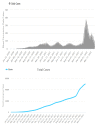Current Artificial Intelligence (AI) Techniques, Challenges, and Approaches in Controlling and Fighting COVID-19: A Review
- PMID: 35627437
- PMCID: PMC9140632
- DOI: 10.3390/ijerph19105901
Current Artificial Intelligence (AI) Techniques, Challenges, and Approaches in Controlling and Fighting COVID-19: A Review
Abstract
SARS-CoV-2 (COVID-19) has been one of the worst global health crises in the 21st century. The currently available rollout vaccines are not 100% effective for COVID-19 due to the evolving nature of the virus. There is a real need for a concerted effort to fight the virus, and research from diverse fields must contribute. Artificial intelligence-based approaches have proven to be significantly effective in every branch of our daily lives, including healthcare and medical domains. During the early days of this pandemic, artificial intelligence (AI) was utilized in the fight against this virus outbreak and it has played a major role in containing the spread of the virus. It provided innovative opportunities to speed up the development of disease interventions. Several methods, models, AI-based devices, robotics, and technologies have been proposed and utilized for diverse tasks such as surveillance, spread prediction, peak time prediction, classification, hospitalization, healthcare management, heath system capacity, etc. This paper attempts to provide a quick, concise, and precise survey of the state-of-the-art AI-based techniques, technologies, and datasets used in fighting COVID-19. Several domains, including forecasting, surveillance, dynamic times series forecasting, spread prediction, genomics, compute vision, peak time prediction, the classification of medical imaging-including CT and X-ray and how they can be processed-and biological data (genome and protein sequences) have been investigated. An overview of the open-access computational resources and platforms is given and their useful tools are pointed out. The paper presents the potential research areas in AI and will thus encourage researchers to contribute to fighting against the virus and aid global health by slowing down the spread of the virus. This will be a significant contribution to help minimize the high death rate across the globe.
Keywords: COVID-19; artificial intelligence; dataset; drones; genome and protein sequences; global health; machine learning; medical imaging; open resource; robotics.
Conflict of interest statement
The authors declare no conflict of interest.
Figures
Similar articles
-
Approaches Based on Artificial Intelligence and the Internet of Intelligent Things to Prevent the Spread of COVID-19: Scoping Review.J Med Internet Res. 2020 Aug 10;22(8):e19104. doi: 10.2196/19104. J Med Internet Res. 2020. PMID: 32584780 Free PMC article.
-
Combating COVID-19 Crisis using Artificial Intelligence (AI) Based Approach: Systematic Review.Curr Top Med Chem. 2024;24(8):737-753. doi: 10.2174/0115680266282179240124072121. Curr Top Med Chem. 2024. PMID: 38318824
-
Exploring the Potential of Artificial Intelligence and Machine Learning to Combat COVID-19 and Existing Opportunities for LMIC: A Scoping Review.J Prim Care Community Health. 2020 Jan-Dec;11:2150132720963634. doi: 10.1177/2150132720963634. J Prim Care Community Health. 2020. PMID: 32996368 Free PMC article.
-
Development and evaluation of a machine learning-based in-hospital COVID-19 disease outcome predictor (CODOP): A multicontinental retrospective study.Elife. 2022 May 17;11:e75985. doi: 10.7554/eLife.75985. Elife. 2022. PMID: 35579324 Free PMC article.
-
A COVID-19 Pandemic Artificial Intelligence-Based System With Deep Learning Forecasting and Automatic Statistical Data Acquisition: Development and Implementation Study.J Med Internet Res. 2021 May 20;23(5):e27806. doi: 10.2196/27806. J Med Internet Res. 2021. PMID: 33900932 Free PMC article.
Cited by
-
Exploring the Role of Mobile Apps for Insomnia in Depression: Systematic Review.J Med Internet Res. 2024 Oct 18;26:e51110. doi: 10.2196/51110. J Med Internet Res. 2024. PMID: 39423009 Free PMC article.
-
Permafrost viremia and immune tweening.Bioinformation. 2023 Jun 30;19(6):685-691. doi: 10.6026/97320630019685. eCollection 2023. Bioinformation. 2023. PMID: 37885785 Free PMC article.
-
Artificial Intelligence in Healthcare: Perception and Reality.Cureus. 2023 Sep 20;15(9):e45594. doi: 10.7759/cureus.45594. eCollection 2023 Sep. Cureus. 2023. PMID: 37868407 Free PMC article. Review.
References
-
- World Health Organization (WHO) Website. [(accessed on 30 March 2020)]. Available online: https://www:who:int/dg/speeches/detail/who-director-general-s-opening-re....
-
- World Health Organization (WHO) Website. [(accessed on 30 March 2020)]. Available online: https://www:who:int/news-room/detail/30-01-2020-statement-on-the-second-...
-
- Coronavirus Disease (COVID-19) Situation Dashboard. [(accessed on 30 March 2020)]. Available online: https://www:who:int/redirect-pages/page/novel-coronavirus-(covid-19)-sit....
Publication types
MeSH terms
LinkOut - more resources
Full Text Sources
Medical
Miscellaneous





